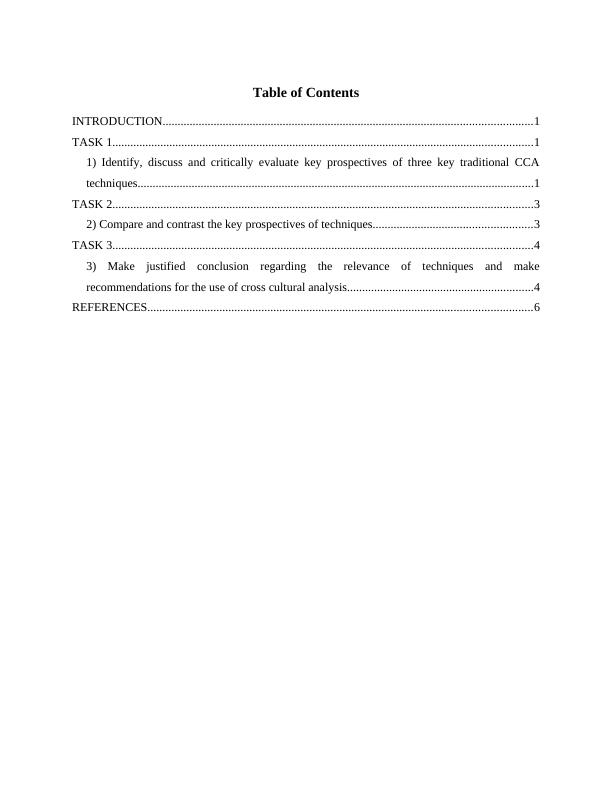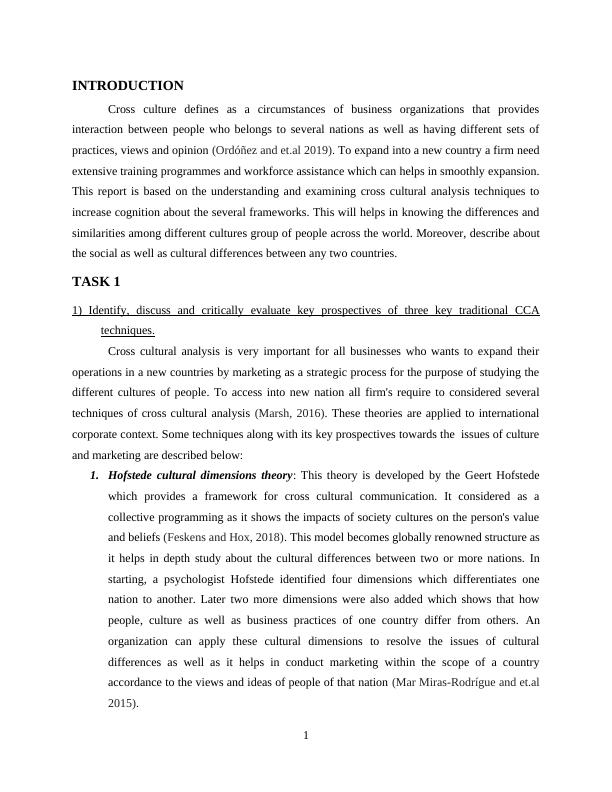Cross Cultural Analysis Techniques: Key Perspectives and Relevance
Added on 2023-01-18
8 Pages2174 Words88 Views
Marketing A Cross
Cultures Assignment
Cultures Assignment

Table of Contents
INTRODUCTION...........................................................................................................................1
TASK 1............................................................................................................................................1
1) Identify, discuss and critically evaluate key prospectives of three key traditional CCA
techniques....................................................................................................................................1
TASK 2............................................................................................................................................3
2) Compare and contrast the key prospectives of techniques.....................................................3
TASK 3............................................................................................................................................4
3) Make justified conclusion regarding the relevance of techniques and make
recommendations for the use of cross cultural analysis..............................................................4
REFERENCES................................................................................................................................6
INTRODUCTION...........................................................................................................................1
TASK 1............................................................................................................................................1
1) Identify, discuss and critically evaluate key prospectives of three key traditional CCA
techniques....................................................................................................................................1
TASK 2............................................................................................................................................3
2) Compare and contrast the key prospectives of techniques.....................................................3
TASK 3............................................................................................................................................4
3) Make justified conclusion regarding the relevance of techniques and make
recommendations for the use of cross cultural analysis..............................................................4
REFERENCES................................................................................................................................6

INTRODUCTION
Cross culture defines as a circumstances of business organizations that provides
interaction between people who belongs to several nations as well as having different sets of
practices, views and opinion (Ordóñez and et.al 2019). To expand into a new country a firm need
extensive training programmes and workforce assistance which can helps in smoothly expansion.
This report is based on the understanding and examining cross cultural analysis techniques to
increase cognition about the several frameworks. This will helps in knowing the differences and
similarities among different cultures group of people across the world. Moreover, describe about
the social as well as cultural differences between any two countries.
TASK 1
1) Identify, discuss and critically evaluate key prospectives of three key traditional CCA
techniques.
Cross cultural analysis is very important for all businesses who wants to expand their
operations in a new countries by marketing as a strategic process for the purpose of studying the
different cultures of people. To access into new nation all firm's require to considered several
techniques of cross cultural analysis (Marsh, 2016). These theories are applied to international
corporate context. Some techniques along with its key prospectives towards the issues of culture
and marketing are described below:
1. Hofstede cultural dimensions theory: This theory is developed by the Geert Hofstede
which provides a framework for cross cultural communication. It considered as a
collective programming as it shows the impacts of society cultures on the person's value
and beliefs (Feskens and Hox, 2018). This model becomes globally renowned structure as
it helps in depth study about the cultural differences between two or more nations. In
starting, a psychologist Hofstede identified four dimensions which differentiates one
nation to another. Later two more dimensions were also added which shows that how
people, culture as well as business practices of one country differ from others. An
organization can apply these cultural dimensions to resolve the issues of cultural
differences as well as it helps in conduct marketing within the scope of a country
accordance to the views and ideas of people of that nation (Mar Miras‐Rodrígue and et.al
2015).
1
Cross culture defines as a circumstances of business organizations that provides
interaction between people who belongs to several nations as well as having different sets of
practices, views and opinion (Ordóñez and et.al 2019). To expand into a new country a firm need
extensive training programmes and workforce assistance which can helps in smoothly expansion.
This report is based on the understanding and examining cross cultural analysis techniques to
increase cognition about the several frameworks. This will helps in knowing the differences and
similarities among different cultures group of people across the world. Moreover, describe about
the social as well as cultural differences between any two countries.
TASK 1
1) Identify, discuss and critically evaluate key prospectives of three key traditional CCA
techniques.
Cross cultural analysis is very important for all businesses who wants to expand their
operations in a new countries by marketing as a strategic process for the purpose of studying the
different cultures of people. To access into new nation all firm's require to considered several
techniques of cross cultural analysis (Marsh, 2016). These theories are applied to international
corporate context. Some techniques along with its key prospectives towards the issues of culture
and marketing are described below:
1. Hofstede cultural dimensions theory: This theory is developed by the Geert Hofstede
which provides a framework for cross cultural communication. It considered as a
collective programming as it shows the impacts of society cultures on the person's value
and beliefs (Feskens and Hox, 2018). This model becomes globally renowned structure as
it helps in depth study about the cultural differences between two or more nations. In
starting, a psychologist Hofstede identified four dimensions which differentiates one
nation to another. Later two more dimensions were also added which shows that how
people, culture as well as business practices of one country differ from others. An
organization can apply these cultural dimensions to resolve the issues of cultural
differences as well as it helps in conduct marketing within the scope of a country
accordance to the views and ideas of people of that nation (Mar Miras‐Rodrígue and et.al
2015).
1

End of preview
Want to access all the pages? Upload your documents or become a member.
Related Documents
Cross-Cultural Analysis - Traditional Techniques and Relevance in the 21st Centurylg...
|8
|1900
|90
Marketing across Cultureslg...
|9
|2110
|76
Cross-Cultural Analysis in the 21st Centurylg...
|7
|2033
|96
Cross-Cultural Analysis - Traditional Techniques in the 21st Centurylg...
|9
|2176
|61
(PDF) Marketing Across Cultureslg...
|7
|2116
|90
Cross-Cultural Analysis Techniques: Hofstede, Hall and Hall, Handylg...
|7
|2081
|30
